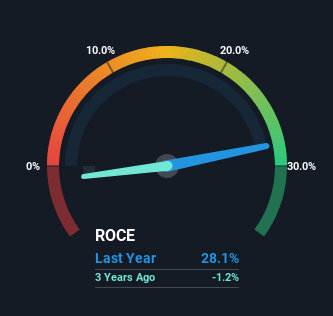If you're looking for a multi-bagger, there's a few things to keep an eye out for. In a perfect world, we'd like to see a company investing more capital into its business and ideally the returns earned from that capital are also increasing. Basically this means that a company has profitable initiatives that it can continue to reinvest in, which is a trait of a compounding machine. With that in mind, the ROCE of JUNGDAWN (KOSDAQ:208140) looks great, so lets see what the trend can tell us.
What Is Return On Capital Employed (ROCE)?
For those who don't know, ROCE is a measure of a company's yearly pre-tax profit (its return), relative to the capital employed in the business. The formula for this calculation on JUNGDAWN is:
Return on Capital Employed = Earnings Before Interest and Tax (EBIT) ÷ (Total Assets - Current Liabilities)
0.28 = ₩36b ÷ (₩196b - ₩69b) (Based on the trailing twelve months to December 2023).
Thus, JUNGDAWN has an ROCE of 28%. That's a fantastic return and not only that, it outpaces the average of 7.0% earned by companies in a similar industry.
Check out our latest analysis for JUNGDAWN

While the past is not representative of the future, it can be helpful to know how a company has performed historically, which is why we have this chart above. If you want to delve into the historical earnings , check out these free graphs detailing revenue and cash flow performance of JUNGDAWN.
The Trend Of ROCE
Investors would be pleased with what's happening at JUNGDAWN. Over the last five years, returns on capital employed have risen substantially to 28%. The amount of capital employed has increased too, by 85%. So we're very much inspired by what we're seeing at JUNGDAWN thanks to its ability to profitably reinvest capital.
The Key Takeaway
To sum it up, JUNGDAWN has proven it can reinvest in the business and generate higher returns on that capital employed, which is terrific. Investors may not be impressed by the favorable underlying trends yet because over the last five years the stock has only returned 13% to shareholders. Given that, we'd look further into this stock in case it has more traits that could make it multiply in the long term.
Like most companies, JUNGDAWN does come with some risks, and we've found 2 warning signs that you should be aware of.
If you'd like to see other companies earning high returns, check out our free list of companies earning high returns with solid balance sheets here.
New: Manage All Your Stock Portfolios in One Place
We've created the ultimate portfolio companion for stock investors, and it's free.
• Connect an unlimited number of Portfolios and see your total in one currency
• Be alerted to new Warning Signs or Risks via email or mobile
• Track the Fair Value of your stocks
Have feedback on this article? Concerned about the content? Get in touch with us directly. Alternatively, email editorial-team (at) simplywallst.com.
This article by Simply Wall St is general in nature. We provide commentary based on historical data and analyst forecasts only using an unbiased methodology and our articles are not intended to be financial advice. It does not constitute a recommendation to buy or sell any stock, and does not take account of your objectives, or your financial situation. We aim to bring you long-term focused analysis driven by fundamental data. Note that our analysis may not factor in the latest price-sensitive company announcements or qualitative material. Simply Wall St has no position in any stocks mentioned.
About KOSDAQ:A208140
JUNGDAWN
Engages in poultry farming, delivery, processing, and sales of duck meat and duck down.
Flawless balance sheet second-rate dividend payer.
Market Insights
Community Narratives



